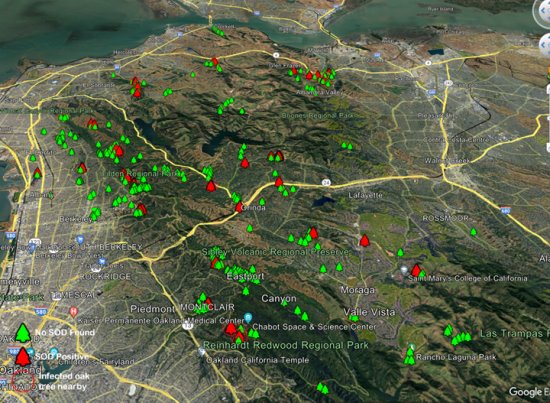
| ||||||
SOD is an invasive, non-native disease, that harmlessly infects the leaves of many plant species, but in our iconic and invaluable California Live Oaks, obstructs the circulation of nutrients in the trunk and typically kills them. Using the Bay leaves as a vector, it is highly infectious, and has spread from the Bay Area south to just north of San Luis Obispo and north into Oregon, killing millions of oaks. Its "Sudden" name reflects the fact that infected trees exhibit few symptoms until all of their leaves turn brown in a matter of days indicating they have died.
Professor Matteo Garbelotto's lab at UC Berkeley has been studying SOD and ways to combat it since its arrival in California. A key part of these efforts is the lab's annual spring SOD Blitz-signifying intense effort in a short period of time-a citizen science survey of Bay leaves with characteristics that are produced by SOD, but also other causes. To determine the actual presence of SOD, the leaves are analyzed over the summer, and in the fall the location and actual infected status of each sample is displayed on a Google Earth map viewable at www.sodblitz.org. There is no cure for infected trees, so the Blitz information is critical to determining the areas most at risk in which to focus efforts to prevent infections; the fall is the best time for the measures to protect the oaks against infection in the following spring.
Last year, following years of drought, SOD was at its lowest level since the Blitz began, and absent or at least undetectable in several previously infected areas in the state. Data suggests the possibility that this year's wet weather may result in many less infected oaks than expected based on the historical data, and the Blitz this year will have eagerly awaited answers.
Infection rates have fallen from their most recent highs in 2017 to the lowest level on record last year, from 7.4% to 4.4% in locations west of the East Bay hills, and precipitously from 15.7% to 1.3% in areas on the other side, such as Orinda and Moraga. This year's Blitz data will help minimize increases from these low levels, particularly in Lamorinda, by revealing re-emergent areas where efforts should be focused in the fall to block SOD from entering the oaks in the spring of 2024. The more data from the Blitz this year, the better the chance to keep it contained.
Readers interested in participating in this year's Blitz can follow the SOD Blitz 2023 Spring Survey - Get Started Here link on the www.sodblitz.org page. Here you learn the Blitz protocol for identifying and collecting symptomatic Bay leaves, which you apply in whatever areas for whatever amount of time you have during your collection weekend, May 12-14 in the East Bay this year.
See www.sodblitz.org for results of past Blitzes, more information about SOD and programs to assess and manage risks for the public and professional arborists. The SODMAP mobile app described in the "SOD Risk Assessment" shows the risk of infection at the location of the mobile phone, and "3 steps to manage sudden oak death" and "Best Management Practices" cover steps for protection. The OakSTeP program is for professionals; watch the site for SOD Treatment Training workshops for the public in the fall.
Reach the reporter at:
